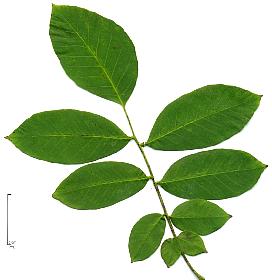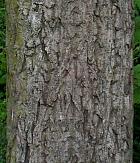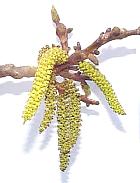Walnut, Juglans regia
tree of the family Juglandaceae (Walnut, Wingnut),

Etymology: "Juglans" comes from Latin "Jovis Glans", "Jupiter glans".
Origin: the Walnut was introduced from Persia to Greece, since the earliest times, then in Italy by the Romans. One nevertheless found more ancient, fossilized pollens, which let assume that the Walnut existed in France before being completely forgotten.
Habitat: the Walnut grows in the light, isolated (due to its noxiousness: leaves and roots contain the juglon, a toxic substance, which gives troubles to those who dwell beneath its foliage and attacks the surrounding trees). It appreciates the deep, well drained soils.
Hardiness: the Walnut is very resistant to cold. It supports cold until -35 °C or -31 °F (zone 4). In the opposite, extreme heat is more harmful to it than cold.
Lifespan: 300 years.
Height: 20-30 m tall.
Rate of Growth: fast.
Trunk: straight. Its roots are long, strong, little trimmed with fibres and deep (swivel).
Form (insulated tree): ventilated, rounded, broad crown (few branches).
Bark first smooth, silver grey, then cracked or deeply cracked longitudinally.
Deciduous foliage. Leaves alternate, big (30-50 cm) composed of 7 to 11 oval leaflets of increasing size towards end. The final leaflet is bigger and can attain 15 cm long. Leaflets are glabrous, thick or even tough and aromatic. Their margin is smooth.
The Walnut flourishes after 15-25 years. Its flowers in catkins appear in April, before leaves. They are born of big final buds. The male flowers are grouped in catkins pendulous some centimetres long and females in groups from 1 to 5, at the end of the stems of the year. They carry 6 - 30 stamens (character determining for the family). (character determining for the family).
Fruit: The fruit is a drupe the seed of which is the nut and the pulp sheds at maturity (very messy if we dissects to extract the nut). Production of the walnut begins at about the fifteenth year, and this during 200 years, but at the end of 70-100 years, its nut production weakens.
Legends and traditions: Among the Romans, the Walnut was the tree of Hell and of Perséphone. In The Middle Ages, the witches' sabbath took place under a huge walnut close to Benevento: this magical character comes undoubtedly from the fact that the walnut is not affected by the lightning. In Celtic astrology, the walnut is implacable, surprising and full of contrasts...
Sayings: "When it is raining on May 3rd, no nut in the walnut".
" In mid-August, nuts have the russet belly".
The Walnut is described in the Encyclopédie ou Dictionnaire raisonné des sciences, des arts et des métiers (written between 1751 and 1772 under the direction of Diderot).
Uses: the walnut stain (extract of the pulpit of the fruit) serves in wood tincture and in pigment for oil painting. The Walnut is cultivated for the nut (Valley of Drôme, Isère, Périgord), edible as such, or pressed to extract from it a very good oil. The least refined oil serves for making the soap. Finally the Walnut wood is reputed for rifle butts and quality pieces of furniture. |